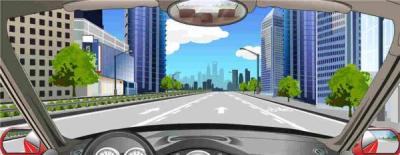1、What should the driver do when he/she sees this sign on the road?

A、Use emergency braking
B、Slow down and take a look
C、Sound the horn intermittently
D、Prepare to bypass
Answer:B
2、Drivers are allowed to cross the broken and solid white line on the road when changing lanes or pulling over.

A、Right
B、Wrong
Answer:A
3、What should be checked before driving?
A、No parts need to be checked
B、Whether the tires have been cleaned
C、Where the spare tire is placed
D、The fastening and air pressure of tires
Answer:D
4、When temporarily parking on a raining day, what kind of lamp should the driver turn on?
A、Front and back fog lamps
B、Hazard warning lamp
C、Headlamp
D、Reversing lamp
Answer:B
5、When removing a wounded person suffering spinal fracture, the rescuer should never help the wounded person to walk. He may be carried away with a soft stretcher.
A、Right
B、Wrong
Answer:B
6、When braking, the steering will become impossible if the front wheels are blocked
A、Right
B、Wrong
Answer:A
7、The area in the yellow rectangle markings on the right side of the road indicates that temporary stopping is permitted here.

A、Right
B、Wrong
Answer:B
8、When the motor vehicle stops on an uphill section, how should the driver use the foot brake?
A、Earlier than on a level road
B、Later than on a level road
C、As timely as on a level road
D、Strongly depress the foot brake pedal
Answer:B
9、Which is the correct way to use a fire extinguisher?
A、Stand on the leeward side
B、Direct the fire extinguisher at the source of fire
C、Try to approach the source of fire as close as possible
D、Direct the fire extinguisher at the flames
Answer:B
10、The diamond-shaped broken line warns that drivers should drive at a lower speed on the road sections ahead.

A、Right
B、Wrong
Answer:A
11、Under such circumstance at an intersection. motor vehicle drivers should be prepared to stop and yieldat any time.

A、Right
B、Wrong
Answer:A
12、What is the intersection ahead indicated by the right sign?

A、T-shaped intersection
B、Y-shaped intersection
C、Cross-shaped intersection
D、Roundabout
Answer:D
13、When braking failure happens to a fast-moving motor vehicle, what should be done by the driver to brake?
A、Continuously depressing the brake pedal
B、Immediately changing to a low gear to reduce speed and using the handbrake
C、Swiftly depressing the clutch pedal
D、Swiftly pulling up the handbrake
Answer:B
14、When rescuing a wounded person who has been poisoned by toxic gas, which of the following measures should be taken first?
A、Prevent heat loss
B、Bring him/her to a place with fresh air
C、Give him/her artificial respiration
D、Depress the heart over the chest
Answer:B
15、The sign in front gives information about the direction of road exits.

A、Right
B、Wrong
Answer:A
16、If a driver finds there is no vehicle behind, he/she may change lanes without turning on the indicator.
A、Right
B、Wrong
Answer:B
17、When a motor vehicle encounters thick fog on an expressway and the visibility is poor, the driver should immediately brake and stop.
A、Right
B、Wrong
Answer:B
18、Motor vehicle drivers may make a U-turn in the broken line area as long as it will not affect the normal traffic flow.

A、Right
B、Wrong
Answer:A
19、Which is the wrong measure to avoid tire burst?
A、Reduce tire pressure
B、Check tires regularly
C、Remove foreign matters from the tire tread grooves timely
D、Replace tires that have cracks or deep cuts
Answer:A
20、The sign on the right warns of a hump bridge right ahead.

A、Right
B、Wrong
Answer:B